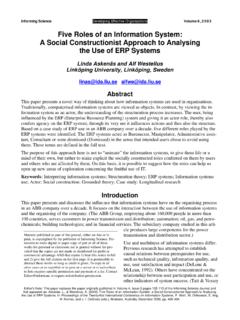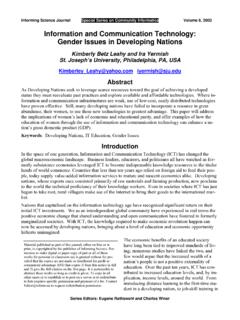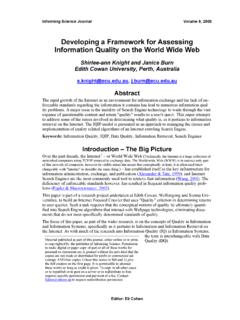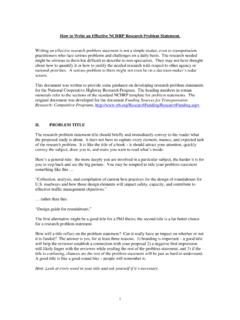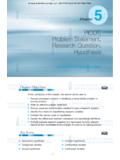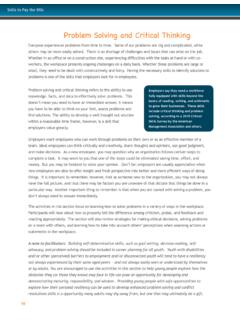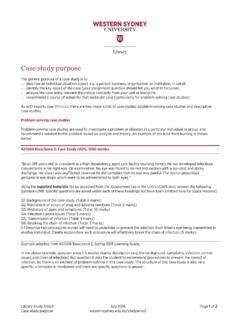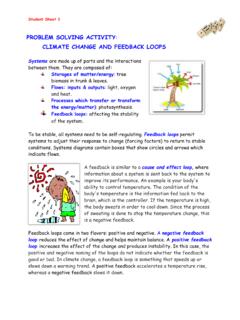Transcription of Framework of Problem-Based Research: A Guide for Novice ...
1 Informing Science: the International Journal of an Emerging Transdiscipline Volume 11, 2008 Editor: Eli Cohen Framework of Problem-Based research : A Guide for Novice Researchers on the Development of a research -Worthy problem Timothy J. Ellis and Yair Levy Nova Southeastern University Graduate School of Computer and Information Sciences Fort Lauderdale, Florida, USA Abstract This paper introduces the importance of a well-articulated, research -worthy problem statement as the centerpiece for any viable research . The aim of this work is to help Novice researchers under-stand the value of Problem-Based research by providing a practical Guide on the development of a well articulated and viable statement of a research -worthy problem as the starting point for all research .
2 Additionally, this paper explores the interaction of the problem with the other funda-mental elements of scholarly research including the research topic, goals, research questions, methodology, results, and conclusions. Scaffolding for articulating a research -worthy problem is provided in the form of a deconstruction of the expression into definitions of its component terms, followed by a discussion of what is not a research -worthy problem . A roadmap on locating problems that could support scholarly research is provided. The theoretical foundation is placed into practice by examining some problem statements and proposing a template for crafting an effective statement.
3 Keywords: research methodology, research problem , Problem-Based research , research ques-tions, theory- based research , doctoral education. Introduction The importance of basing research on a well-articulated problem statement is well accepted across disciplines such as information systems, education, and engineering (Creswell, 2005; Hicks & Turner, 1999; Sekaran, 2003). Unfortunately, just what constitutes a research -worthy problem is not readily apparent, in particular for Novice researchers. Although most scholars would agree that not everything that is problematic could serve as the starting point for meaning-ful research , it is not easy to identify just what does constitute such a problem .
4 According to Ker-linger and Lee (2000), the identification of the research problem is the most difficult and important part of the whole [ research ] process (p. 15). To a very great extent, Supreme Court Justice Pot-ter Stewart s opinion regarding obscen-ity seems to describe the feeling of many scholars regarding research -worthy problems: I shall not today at-tempt further to define the kinds of ma-terial I understand to be embraced .. Material published as part of this publication, either on-line or in print, is copyrighted by the Informing Science Institute.
5 Permission to make digital or paper copy of part or all of these works for personal or classroom use is granted without fee provided that the copies are not made or distributed for profit or commercial advantage AND that copies 1) bear this notice in full and 2) give the full citation on the first page. It is per-missible to abstract these works so long as credit is given. To copy in all other cases or to republish or to post on a server or to redistribute to lists requires specific permission and payment of a fee. Contact to request redistribution permission.
6 Framework of Problem-Based research 18 [b]ut I know it when I see it .. ("Jacobellis v. Ohio", 1964). Unfortunately, such an approach does not appear to be helpful, especially for Novice researchers. Thus, this paper attempts to ad-dress the critical issue of identifying and establishing the research -worthiness of a problem . This paper explores the concept of Problem-Based research beyond the know it when I see it approach. In the balance of this introduction, the argument for basing research on a well-defined problem will be detailed and the interaction of the problem with the other fundamental elements of scholarly research will be explored.
7 The second section builds a scaffold for defining re-search-worthy problem by deconstructing the expression. The third section places the theoretical foundation laid in the first two sections into practice by examining some effective problem state-ments. The fourth section provides a practical Guide on locating problems that could support scholarly research . Finally, a summary and recommendations are provided. Why Problem-Based research ? I keep six honest serving-men (They taught me all I knew); Their names are What and Why and When And How and Where and Who (Kipling, 1902/1988, p.)
8 3) Kipling s (1902/1988) honest serving-men have been used to form the basis for enquiry in a number of disciplines. Although the poem has long been the accepted mantra of journalists, it applies equally well to scientific enquiry (Sharp, 2002). A well-structured, properly-reported study must provide answers to all questions regarding the what, why, when, how, where, and who associated with the research . The problem statement offers the context necessary for addressing the why question (Tracy, 2007). According to Kerlinger and Lee (2000), in essence a scientist is driven by an inner desire to un-derstand why something is as it is (p.
9 15). Moreover, they note that scientists are restless until they find an explanation to the phenomena. One cannot place value on research without a clear understanding of, first, why that research had been conducted (Creswell, 2005). In the case of a great deal of reported research , at least part of the answer to why lies in the need to publish in or-der to earn a degree, tenure, or promotion (Sharp, 2002). If such rather practical considerations are the only motivators for the research , it is hard to imagine the research producing results of much interest or value.
10 What makes research of interest is how it will impact future research and other researchers, not the author. This impact is most clearly evidenced by addressing a problem that has some manner of impact on the reader. Answering the question Why conduct the research ? with an effective statement of the problem doesn t just add meaningfulness to that research ; it also serves as the first step in addressing that problem (Sternberg, in press). A careful statement of the problem goes a long way toward its solution (Hicks & Turner, 1999, p.)
